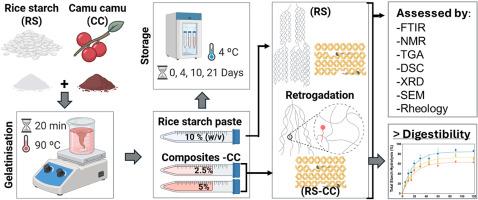Camu Camu (Myrciaria dubia)多酚类物质可调节大米淀粉在热复合后的消化率,但在储存期间无调节作用
IF 11
1区 农林科学
Q1 CHEMISTRY, APPLIED
引用次数: 0
摘要
研究了camu camu (CC, M. dubia)淀粉配体对普通水稻淀粉体系(RS, 10% w/v)在络合后和冷藏过程中不同时间消化率的影响。具体来说,RS和RS- cc复合材料(2.5%和5% w/v)被凝胶化(90°C, 20分钟),冷却并在4°C下储存长达21天。采用FTIR、1H NMR、13C NMR、TGA、DSC、XRD、SEM和流变学等多尺度表征。此外,还对这些样品的体外消化率、酚释放量、硬度和协同作用进行了评估。FTIR和1H NMR通过RS和cc衍生的羟基肉桂酸和/或棕榈酸之间的分子间氢键证实了络合作用。DSC (ΔHr101-111°C = 7-15 J g−1)、XRD (2θ = 13.0°、19.8°)和NMR均显示出v6型螺旋的形成,但非包合相互作用占主导地位。RS-CC复合材料具有软凝胶特性(G′~ 20 MPa, G′~ 6 MPa),具有致密的微观结构和破坏的短程分子秩序(R1047/1022 ~ 0.5, R1022/995 ~ 1.1)。CC络合可显著调节糊化和冷却后的淀粉消化率(C∞~ 69 mg∙100 g−1,RDS ~ 48%, SDS ~ 19%, RSF ~ 33%; p < 0.05)。然而,这种效果在储存期间没有保持。4天后,由于CC酚类物质对直链淀粉降解的抑制作用,RS凝胶和复合材料的消化性能没有显著差异。随着时间的推移,淀粉结构的重排限制了酚类物质在体外肠道的释放,导致最初的调节作用丧失。这些发现为络合-退化-消化率关系提供了新的见解,可以为持续和调整消化率的淀粉基食品的重新配方提供信息。本文章由计算机程序翻译,如有差异,请以英文原文为准。

Camu camu (Myrciaria dubia) polyphenols modulate rice starch digestibility after thermal complexation but not during storage
The effect of camu camu (CC, M. dubia) starch ligands on the digestibility of normal rice starch systems (RS, 10 % w/v) after complexation and over time during cold storage was investigated. Specifically, RS and RS-CC composites (2.5 % and 5 % w/v) were gelatinised (90 °C, 20 min), cooled and stored at 4 °C for up to 21 days. Multi-scale characterisation was performed using FTIR, 1H NMR, 13C NMR, TGA, DSC, XRD, SEM and rheology. Additionally, the in vitro digestibility, phenolic release, firmness, and syneresis of these samples were evaluated. FTIR and 1H NMR spectra confirmed complexation via intermolecular hydrogen bonds between RS and CC-derived hydroxycinnamic acids and/or palmitic acid. DSC (ΔHr101–111°C = 7–15 J g−1), XRD (2θ = 13.0°, 19.8°) and NMR indicated the formation of V6-type helices, although non-inclusion interactions were predominant. RS-CC composites exhibited soft-gel characteristics (G’∼20 MPa, G’’∼6 MPa) with densely packed microstructures and disrupted short-range molecular order (R1047/1022∼0.5, R1022/995∼1.1). CC complexation significantly modulated starch digestibility after gelatinisation and cooling (C∞∼69 mg∙100 g−1, RDS∼48 %, SDS∼19 %, RSF∼33 %; p < 0.05). However, this effect was not maintained during storage. After 4 days, no significant differences were observed in the digestive properties of the RS gels and composites, due to the inhibitory effect of CC phenolics on amylose retrogradation. Over time, starch structural rearrangements limited the in vitro intestinal release of phenolics, contributing to the loss of the initial modulatory effect. These findings provide new insight into the complexation-retrogradation-digestibility relationship that could inform the reformulation of starch-based foods with sustained and tuned digestibility.
求助全文
通过发布文献求助,成功后即可免费获取论文全文。
去求助
来源期刊

Food Hydrocolloids
工程技术-食品科技
CiteScore
19.90
自引率
14.00%
发文量
871
审稿时长
37 days
期刊介绍:
Food Hydrocolloids publishes original and innovative research focused on the characterization, functional properties, and applications of hydrocolloid materials used in food products. These hydrocolloids, defined as polysaccharides and proteins of commercial importance, are added to control aspects such as texture, stability, rheology, and sensory properties. The research's primary emphasis should be on the hydrocolloids themselves, with thorough descriptions of their source, nature, and physicochemical characteristics. Manuscripts are expected to clearly outline specific aims and objectives, include a fundamental discussion of research findings at the molecular level, and address the significance of the results. Studies on hydrocolloids in complex formulations should concentrate on their overall properties and mechanisms of action, while simple formulation development studies may not be considered for publication.
The main areas of interest are:
-Chemical and physicochemical characterisation
Thermal properties including glass transitions and conformational changes-
Rheological properties including viscosity, viscoelastic properties and gelation behaviour-
The influence on organoleptic properties-
Interfacial properties including stabilisation of dispersions, emulsions and foams-
Film forming properties with application to edible films and active packaging-
Encapsulation and controlled release of active compounds-
The influence on health including their role as dietary fibre-
Manipulation of hydrocolloid structure and functionality through chemical, biochemical and physical processes-
New hydrocolloids and hydrocolloid sources of commercial potential.
The Journal also publishes Review articles that provide an overview of the latest developments in topics of specific interest to researchers in this field of activity.
 求助内容:
求助内容: 应助结果提醒方式:
应助结果提醒方式:


